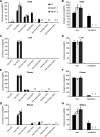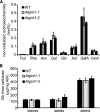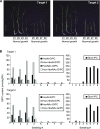GLUCOSAMINE INOSITOLPHOSPHORYLCERAMIDE TRANSFERASE1 (GINT1) Is a GlcNAc-Containing Glycosylinositol Phosphorylceramide Glycosyltransferase
- PMID: 29760197
- PMCID: PMC6053017
- DOI: 10.1104/pp.18.00396
GLUCOSAMINE INOSITOLPHOSPHORYLCERAMIDE TRANSFERASE1 (GINT1) Is a GlcNAc-Containing Glycosylinositol Phosphorylceramide Glycosyltransferase
Abstract
Glycosylinositol phosphorylceramides (GIPCs), which have a ceramide core linked to a glycan headgroup of varying structures, are the major sphingolipids in the plant plasma membrane. Recently, we identified the major biosynthetic genes for GIPC glycosylation in Arabidopsis (Arabidopsis thaliana) and demonstrated that the glycan headgroup is essential for plant viability. However, the function of GIPCs and the significance of their structural variation are poorly understood. Here, we characterized the Arabidopsis glycosyltransferase GLUCOSAMINE INOSITOLPHOSPHORYLCERAMIDE TRANSFERASE1 (GINT1) and showed that it is responsible for the glycosylation of a subgroup of GIPCs found in seeds and pollen that contain GlcNAc and GlcN [collectively GlcN(Ac)]. In Arabidopsis gint1 plants, loss of the GlcN(Ac) GIPCs did not affect vegetative growth, although seed germination was less sensitive to abiotic stress than in wild-type plants. However, in rice, where GlcN(Ac) containing GIPCs are the major GIPC subgroup in vegetative tissue, loss of GINT1 was seedling lethal. Furthermore, we could produce, de novo, "rice-like" GlcN(Ac) GIPCs in Arabidopsis leaves, which allowed us to test the function of different sugars in the GIPC headgroup. This study describes a monocot GIPC biosynthetic enzyme and shows that its Arabidopsis homolog has the same biochemical function. We also identify a possible role for GIPCs in maintaining cell-cell adhesion.
© 2018 American Society of Plant Biologists. All rights reserved.
Figures










Similar articles
-
Glycosylation of inositol phosphorylceramide sphingolipids is required for normal growth and reproduction in Arabidopsis.Plant J. 2017 Jan;89(2):278-290. doi: 10.1111/tpj.13382. Epub 2017 Jan 25. Plant J. 2017. PMID: 27643972
-
Overexpression of a GIPC glycosyltransferase gene, OsGMT1, suppresses plant immunity and delays heading time in rice.Plant Sci. 2023 Jun;331:111674. doi: 10.1016/j.plantsci.2023.111674. Epub 2023 Mar 21. Plant Sci. 2023. PMID: 36948404
-
Characterization and expression analysis of the glycosyltransferase 64 family in rice (Oryza sativa).Gene. 2022 Sep 5;838:146708. doi: 10.1016/j.gene.2022.146708. Epub 2022 Jun 27. Gene. 2022. PMID: 35772655
-
Genetic and Biochemical Mechanisms of Pollen Wall Development.Trends Plant Sci. 2015 Nov;20(11):741-753. doi: 10.1016/j.tplants.2015.07.010. Epub 2015 Oct 3. Trends Plant Sci. 2015. PMID: 26442683 Review.
-
GIPC: Glycosyl Inositol Phospho Ceramides, the major sphingolipids on earth.Plant Signal Behav. 2016;11(4):e1152438. doi: 10.1080/15592324.2016.1152438. Plant Signal Behav. 2016. PMID: 27074617 Free PMC article. Review.
Cited by
-
Loss of THIN EXINE2 disrupts multiple processes in the mechanism of pollen exine formation.Plant Physiol. 2021 Sep 4;187(1):133-157. doi: 10.1093/plphys/kiab244. Plant Physiol. 2021. PMID: 34618131 Free PMC article.
-
Automated mass spectrometry-based profiling of multi-glycosylated glycosyl inositol phospho ceramides (GIPC) reveals specific series GIPC rearrangements during barley grain development and heat stress response.Plant J. 2025 Jun;122(6):e70279. doi: 10.1111/tpj.70279. Plant J. 2025. PMID: 40570361 Free PMC article.
-
Identification of INOSITOL PHOSPHORYLCERAMIDE SYNTHASE 2 (IPCS2) as a new rate-limiting component in Arabidopsis pathogen entry control.Plant J. 2025 Apr;122(2):e70159. doi: 10.1111/tpj.70159. Plant J. 2025. PMID: 40298354 Free PMC article.
-
Sweet Modifications Modulate Plant Development.Biomolecules. 2021 May 18;11(5):756. doi: 10.3390/biom11050756. Biomolecules. 2021. PMID: 34070047 Free PMC article. Review.
-
Sphingolipids with 2-hydroxy fatty acids aid in plasma membrane nanodomain organization and oxidative burst.Plant Physiol. 2022 Jun 1;189(2):839-857. doi: 10.1093/plphys/kiac134. Plant Physiol. 2022. PMID: 35312013 Free PMC article.
References
-
- Bligh EG, Dyer WJ (1959) A rapid method of total lipid extraction and purification. Can J Biochem Physiol 37: 911–917 - PubMed
-
- Buré C, Cacas JL, Wang F, Gaudin K, Domergue F, Mongrand S, Schmitter JM (2011) Fast screening of highly glycosylated plant sphingolipids by tandem mass spectrometry. Rapid Commun Mass Spectrom 25: 3131–3145 - PubMed
-
- Busse-Wicher M, Wicher KB, Kusche-Gullberg M (2014) The exostosin family: proteins with many functions. Matrix Biol 35: 25–33 - PubMed
Publication types
MeSH terms
Substances
LinkOut - more resources
Full Text Sources
Other Literature Sources
Molecular Biology Databases

